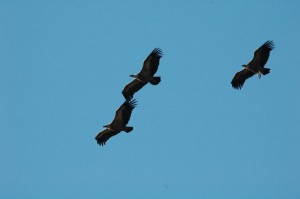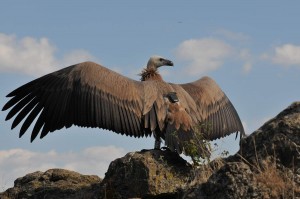Griffon vulture in the Grands Causses
Species: Griffon Vulture
Scavenger raptors are declining worldwide and their disappearance (e.g. in India since 2000), causing sanitary catastrophes together with proliferation of rats and dogs, remind us their ecological significance.
 Griffon vultures (Gyps fulvus) evolved in Europe as commensal of extensive farming. In order to find carrions spread over in the environment in a spatially and temporally stochastic way, they developed social foraging strategies. In particular, the attraction of searching individuals by feeding conspecifics seems to enhance their search efficiency.
Griffon vultures (Gyps fulvus) evolved in Europe as commensal of extensive farming. In order to find carrions spread over in the environment in a spatially and temporally stochastic way, they developed social foraging strategies. In particular, the attraction of searching individuals by feeding conspecifics seems to enhance their search efficiency.
However, questions remain about the importance of individual and social contribution in the success of prospecting behaviour, i.e. before a carrion is discovered.
Three hypotheses prevail:
- vultures disperse at random, with the constraint of topographical features that create vertical updrafts necessary for soaring flight;
- vultures use personal knowledge of food availability and visit, in priority, places with higher probability of finding carrions;
- vultures forage in an actively formed network, being regularly interspersed while observing the behaviour of other flying vultures, in order to aggregate quickly when a carrion is found.
In the 20th century, vulture populations declined due to modifications in farming practices and persecutions. Since 1980 in France, vultures were reintroduced in the south of Massif Central (Grands Causses area), and feeding stations dedicated to vultures were established. Feeding stations are provisioned with carrions collected in nearby farms, where food is therefore predictable spatially and, to a varying degree, temporally.
But vultures can also find carrions away from feeding stations in a more natural way. Hence this network of feeding places offers the possibility to test these hypotheses of prospecting behaviour. In the actual context of recent increase of vulture populations in Spain and suspected damages to living domestic animals, it is urgent to better understand vulture prospecting behaviour.
 Answering these questions necessitates accurate tracking of flying vultures over long time periods, to determine the features of their foraging trips. Recent advances in GPS technology allow such monitoring. Since June 2010, 22 griffon vultures (aged juvenile to 29 years old) are equipped with GPS from the UvA-BiTS, from which data are downloaded via 5 relay antennas, installed at the main feeding site and in front of the main colonies. In summer and autumn, the fix interval was set at 5 minutes during the day, to record precise foraging tracks. In winter, this interval had to be reduced to 30 minutes because of reduced solar radiation.
Answering these questions necessitates accurate tracking of flying vultures over long time periods, to determine the features of their foraging trips. Recent advances in GPS technology allow such monitoring. Since June 2010, 22 griffon vultures (aged juvenile to 29 years old) are equipped with GPS from the UvA-BiTS, from which data are downloaded via 5 relay antennas, installed at the main feeding site and in front of the main colonies. In summer and autumn, the fix interval was set at 5 minutes during the day, to record precise foraging tracks. In winter, this interval had to be reduced to 30 minutes because of reduced solar radiation.
 In summer 2010, vultures used a common home range of 8230 km² around the Jonte and Tarn valleys. Besides the Grands Causses (wide limestone plateaux with extensive sheep farming traditionally used by vultures), their domain ranges from the mountains of Lozère and Cantal to the Mediterranean slopes of the Causses in the Gard and Hérault départements. Individual home range was about 1000 km². On average immature vultures travelled 76 km per day and adults covered 108 km per day. One bird travelled 359 km in a single day. The average flight altitude was about 300 m above ground, but vultures regularly ascended over 1000 m above ground (record at 2577 m above ground = 3294 m asl). The average speed was only 21 km/h (including the time spent soaring) but one bird was recorded at 146 km/h in a glide.
In summer 2010, vultures used a common home range of 8230 km² around the Jonte and Tarn valleys. Besides the Grands Causses (wide limestone plateaux with extensive sheep farming traditionally used by vultures), their domain ranges from the mountains of Lozère and Cantal to the Mediterranean slopes of the Causses in the Gard and Hérault départements. Individual home range was about 1000 km². On average immature vultures travelled 76 km per day and adults covered 108 km per day. One bird travelled 359 km in a single day. The average flight altitude was about 300 m above ground, but vultures regularly ascended over 1000 m above ground (record at 2577 m above ground = 3294 m asl). The average speed was only 21 km/h (including the time spent soaring) but one bird was recorded at 146 km/h in a glide.
These preliminary results are very promising to investigate in detail flight prospecting behaviours and the use of feeding stations in relation to weather, season, breeding status and behaviour of other birds.
Contact Persons:
Olivier Duriez, CNRS-CEFE, 1919 route de Mende, 34293 Montpellier cedex 5, France olivier.duriez@cefe.cnrs.fr
.
François Sarrazin, UMR7204 CNRS-MNHN-UPMC, CERSP, Museum National d’Histoire Naturelle, 61 rue Buffon, 75005 Paris, France sarrazin@mnhn.fr
.
Willem Bouten, IBED-UvA w.bouten@uva.nl
.
Conditions of Use: We kindly ask you to respect the intellectual property rights of the academics posting their work on this website. As such, information and content, including images and data, provided on this website may not be copied, reproduced or republished in any form without the express written permission of the UvA-BiTS manager (UvA-BiTS@uva.nl).
.

